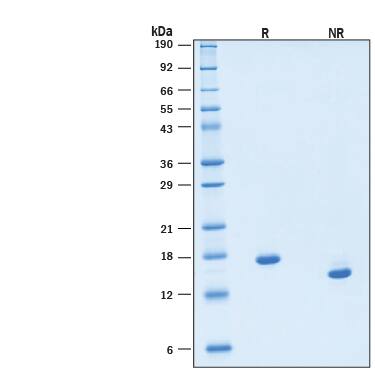Recombinant Human Flt-3 Ligand/FLT3L Protein, Animal-Free Best Seller
R&D Systems, part of Bio-Techne | Catalog # BT-FT3L-AFL
Intended for preclinical researchers who may transition to GMP Flt-3 Ligand/FLT3L for their clinical work

Key Product Details
Learn more about Animal-Free Recombinant Proteins
Product Specifications
Source
E. coli-derived human Flt-3 Ligand/FLT3L protein
Thr27 - Ala181
Produced using non-animal reagents in an animal-free laboratory.
Thr27 - Ala181
Produced using non-animal reagents in an animal-free laboratory.
Purity
>97%, by SDS-PAGE with quantitative densitometry by Coomassie® Blue Staining.
Endotoxin Level
<0.10 EU per 1 μg of the protein by the LAL method.
N-terminal Sequence Analysis
Met & Thr27
Predicted Molecular Mass
18 kDa
SDS-PAGE
17 kDa, under reducing conditions.
Activity
Measured in a cell proliferation assay using OCI-AML5 acute myeloid leukemia cells.
The ED50 for this effect is 0.200-2.00 ng/mL.
The ED50 for this effect is 0.200-2.00 ng/mL.
The
specific activity of Recombinant Human Flt-3 Ligand/FLT3L is >5.00 x 105
units/mg, which is calibrated against the human Flt-3 Ligand WHO Standard
(NIBSC code: 96/532).
Scientific Data Images for Recombinant Human Flt-3 Ligand/FLT3L Protein, Animal-Free
Equivalent Bioactivity of GMP, Animal-Free, and RUO grades of Recombinant Human Flt-3 Ligand/FLT3L.
Equivalent bioactivity of GMP (BT-FT3L-GMP), Animal-Free (Catalog # BT-FT3L-AFL) and RUO (BT-FT3L) grades of Recombinant Human Flt-3 Ligand/FLT3L as measured in a cell proliferation assay using OCI-AML5 acute myeloid leukemia cells (orange, green, red, respectively).Animal-Free™ Recombinant Human Flt-3 Ligand/FLT3L Protein Bioactivity.
Animal-Free™ Recombinant Human Flt-3 Ligand/FLT3L (Catalog # BT-FT3L-AFL) stimulates cell proliferation of OCI-AML5 acute myeloid leukemia cells. The ED50 for this effect is 0.200-2.00 ng/mL.Animal-Free™ Recombinant Human Flt-3 Ligand/FLT3L Protein SDS-PAGE.
2 μg/lane of Animal-Free™ Recombinant Human Flt-3 Ligand/FLT3L Protein (Catalog # BT-FT3L-AFL) was resolved with SDS-PAGE under reducing (R) and non-reducing (NR) conditions and visualized by Coomassie® Blue staining, showing bands at 17 kDa, under reducing conditions.Formulation, Preparation and Storage
BT-FT3L-AFL
| Formulation | Lyophilized from a 0.2 μm filtered solution in PBS with Trehalose. |
| Reconstitution | Reconstitute at 500 μg/mL in PBS. |
| Shipping | The product is shipped at ambient temperature. Upon receipt, store it immediately at the temperature recommended below. |
| Stability & Storage | Use a manual defrost freezer and avoid repeated freeze-thaw cycles.
|
Background: Flt-3 Ligand/FLT3L
References
- Wodnar-Filipowicz, A. (2003) News Physiol. Sci. 18:247.
- Dong, J. et al. (2002) Cancer Biol. Ther. 1:486.
- Gilliland, D.G. and J.D. Griffin (2002) Blood 100:1532.
- Hannum, C. et al. (1994) Nature 368:643.
- Lyman, S.D. et al. (1994) Blood 83:2795.
- Lyman, S.D. et al. (1993) Cell 75:1157.
- Savvides, S.N. et al. (2000) Nat. Struct. Biol. 7:486.
- McClanahan, T. et al. (1996) Blood 88:3371.
- Diener, K.R. et al. (2008) Exp. Hematol. 36:51.
- Farag, S.S. and M.A. Caligiuri (2006) Blood Rev. 20:123.
- Edwan, J.H. et al. (2004) J. Immunol. 172:5016.
Long Name
fms-like Tyrosine Kinase 3 Ligand
Alternate Names
FLG3L, Flt3L, FLT3LG
Gene Symbol
FLT3LG
UniProt
Additional Flt-3 Ligand/FLT3L Products
Product Documents for Recombinant Human Flt-3 Ligand/FLT3L Protein, Animal-Free
Manufacturing Specifications
Animal-Free Manufacturing ConditionsOur dedicated controlled-access animal-free laboratories ensure that at no point in production are the products exposed to potential contamination by animal components or byproducts. Every stage of manufacturing is conducted in compliance with R&D Systems' stringent Standard Operating Procedures (SOPs). Production and purification procedures use equipment and media that are confirmed animal-free.
Production
- All molecular biology procedures use animal-free media and dedicated labware.
- Dedicated fermentors are utilized in committed animal-free areas.
Purification
- Protein purification columns are animal-free.
- Bulk proteins are filtered using animal-free filters.
- Purified proteins are stored in animal-free containers in a dedicated cold storage room.
Quality Assurance
- Low Endotoxin Level.
- No impairment of biological activity.
- High quality product obtained under stringent conditions.
- For ex vivo research or bioproduction, additional documentation can be provided.
Product Specific Notices for Recombinant Human Flt-3 Ligand/FLT3L Protein, Animal-Free
For research use only
